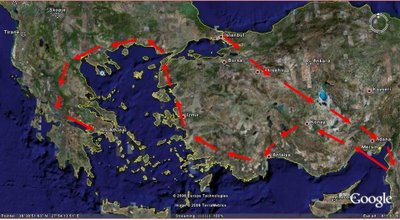***Well this is it, the last post of this trip. It has been a long, and amazing 3 1/2 weeks. We have successfully made it home in one piece, with all of our luggage, and Emily and I are feeling much better. We appreciate all the prayers and emails of encouragement we received while we were gone. We are really looking forward to being able to teach to others what we have learned, in the near future.***
Sunday was spent seeing a final few sites in the city of Rome. We started out at the Colosseum.
Sunday was spent seeing a final few sites in the city of Rome. We started out at the Colosseum.

I learned two interesting facts about the Colosseum. First, it hadn't even started to be built until 72AD so Paul wouldn't have seen it. Secondly, it wasn't finished until 80Ad and since Nero was already long dead by then, we can eliminate the myth that Nero killed Christians in the Colosseum.

This is an inscription on the Arch of Titus which was erected in 81 AD. I found this fascinating. Look closely at the inscription. It depicts the looting of Herod's Temple in Jerusalem by the Roman army after it's destruction in 70AD. Notice the menorah, the table of showbread and the two silver trumpets.

This is a view of the remains of the ancient Roman forum (marketplace).

The ashes of Julius Ceasar are here and people still pay their respects.

This is the "Milliarium Auream" or "Golden Milestone"(at least the base of it). Remember the phrase "All Roads Lead to Rome?" Well this is where mile marker zero was.

Perhaps the highlight of the day was seeing the Mamertine prison. This was the prison Paul (and probably Peter) were imprisoned in right before their executions. (Not to be confused with the apartment prison Paul stayed in during his first Roman imprisonment). Two things to note, first I'm 6 feet tall and my head is touching the ceiling. Secondly, the gray post on the left side of the picture is where the chains would have been attached to.

This is the only flat space in the entire cell. It is very probable that this is the exact location Paul wrote 2nd Timothy from.

For visitors there is now a convenient staircase but Paul (and Peter?) would have been lowered down, and received food through, this hole in the ground. (The white object you see is a person in the cell area).












































